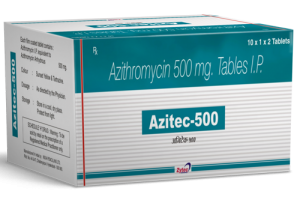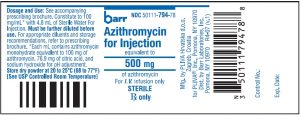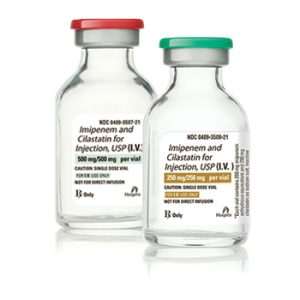Contents
What is Azithromycin?
Azithromycin is an antibiotic that is used for the treatment of variety of bacterial infections such as skin, ear, respiratory infections and sexually transmitted diseases (STDs). The drug is available under generic name Azithromycin and marketed under the various brand names such as Zithromax, Azithrocin and Azyth. Pfizer is accountable for the manufacturing and marketing of Azithromycin.
Furthermore, Azithromycin is marketed as an ophthalmic solution under the brand name AzaSite by Inspire Pharmaceuticals. Azithromycin is a semi-synthetic, relatively broad spectrum, macrolide antibiotic. Azithromycin plays a key role in the treatment of complications related to the bacterial infections such as bronchitis, pneumonia, skin infections and infections of ear and throat.
It is also recommended to treat the sexually transmitted diseases and urinary tract infections. It is also used to prevent or treat the disseminated Mycobacterium avium complex (MAC) infection. Azithromycin (in form of ophthalmic solution) is used to treat bacterial conjunctivitis (a bacterial eye infection).
The drug is also prescribed for the treatment of acute bacterial sinusitis caused by H. influenza, M. catarrhalis or S. pneumonia. Sometimes, it is also used to treat the infection of H. pylori and Legionnaires’ disease (inflammatory lung infection caused by Legionella). It is also prescribed for the treatment of whooping cough. Azithromycin is a derivative of erythromycin and available as a dihydrate salt.
It is a semi-synthetic aliphatic heteromonocyclic antimicrobial agent with a molecular formula C38H72N2O12. The drug is a dihydrate salt of (2R,3S,4R,5R,8R,10R,11R,12S,13S,14R)-11-{[(2S,3R,4S,6R)-4-(dimethylamino)-3-hydroxy-6-methyloxan-2-yl]oxy}-2-ethyl-3,4,10-trihydroxy-13-{[(2R,4R,5S,6S)-5-hydroxy-4-methoxy-4,6-dimethyloxan-2-yl]oxy}-3,5,6,8,10,12,14-heptamethyl-1-oxa-6-azacyclopentadecan-15-one.
Azithromycin is available in tablet and oral suspension form for oral administration as well as in the form of ophthalmic solution. Azithromycin tablets are available in two different dosages of 250 mg and 500 mg, oral suspensions are available in two different dosages of 100 mg/5ml and 200 mg/5ml and both forms contain azithromycin dihydrate as active ingredient.
Azithromycin ophthalmic solution (AzaSite®) is available as 1% sterile solution which is an off-white viscous liquid. The dose of Azithromycin varies depending upon the age and diseased state of the patient.

What is Imipenem?

This medication is an antibiotic (antibacterial drug) that is used to treat various infections caused by gram-negative and gram-positive aerobic and anaerobic bacteria, including many multiresistant strains. Chemically, Imipenem (also known as Primaxin) is a semisynthetic thienamycin (β-lactam antibiotic also known as carbapenem-type antibiotic) with a broad spectrum antibacterial activity.
The drug is highly stable and resistant to the β-lactamase enzymes, therefore provide effective treatment against infections not readily treated with other antibiotics. The drug was discovered by Burton Christensen, William Leanza, and Kenneth Wildonger collectively in the year 1980.
The drug is commonly prescribed for the treatment of bacterial infections caused by Alcaligenes xylosoxidans, Acinetobacter spp, Bacteroides spp, Clostridium spp, Citrobacter spp, Escherichia coli, Enterobacter spp, Gardnerella vaginalis, Haemophilus parainfluenzae, Haemophilus influenzae, Klebsiella spp, Nocardia spp, Proteus vulgaris, Pseudomonas aeruginosa, Rhodococcus equi, Staphylococcus aureus (penicillinase-producing), Serratia marcescens, Staphylococcus epidermidis, Streptococcus pyogenes, Streptococcus pneumonia and group B/D streptococci.
The drug is particularly used to treat the infections caused by Pseudomonas aeruginosa and the Enterococcus species. The drug was originally a crystalline derivative of thienamycin, produced by Streptomyces cattleya. Imipenem chemically belongs to the class of organic compounds known as thienamycins.
Structurally, Imipenem is a beta-lactam antibiotics but differ from penicillins in having the thiazolidine sulfur atom replaced by carbon. Imipenem is chemically known as (5R,6S)-3-[[2-(formimidoylamino)ethyl]thio]-6[(R)-1-hydroxyethyl]-7-oxo-1-azabicyclo[3.2.0]hept-2-ene-2-carboxylic acid monohydrate. The drug is soluble in water and an off-white, nonhygroscopic crystalline in texture.
The empirical formula and molecular weight of Imipenem is C12H17N3O4S•H2O and 317.37 da, respectively. The drug is quickly metabolized and degraded in the kidney through renal enzyme dehydropaptidase, therefore, it is always co administrated with Cilastatin (a chemical compound which inhibits the renal enzyme dehydropeptidase) to prevent its renal degradation and inactivation.
The drug is available for intravenous use in powder form, in solution form for infusion as well as sterile injectable formulation. This medication is given by injection into a muscle or vein, usually every 6 to 8 hours or as directed by your doctor. The dosage is based on your medical condition and response to treatment. The dose of Imipenem varies depending upon the age and diseased state of the patient.
How Azithromycin and Imipenem work?
Azithromycin is effective against gram positive bacteria such as Staphylococcus aureus, S. agalactiae, S. pneumonia and pyogenes, gram-negative bacteria such as Haemophilus ducreyi, H. influenza, Moraxella catarrhalis and Neisseria gonorrhoeae and some other bacteria like Chlamydophila pneumonia, Chlamydia trachomatis and Mycoplasma pneumonia.
Azithromycin is a macrolides antibiotic (such as Erythromycin and Carbomycin) which acts by inhibiting the bacterial protein synthesis, quorum-sensing and formation of bacterial biofilm. Macrolides primarily act through enhancing the dissociation of peptidyl-tRNA from ribosome, thus inhibiting transpeptidation and translocation step of protein synthesis (an intermediate steps of protein synthesis).
It has been observed that Azithromycin binds with the 50S subunit of ribosome and interferes with polypeptide synthesis. Therefore, it is predicted that stimulated dissociation of peptidyl-tRNA from ribosome is the major mechanism of action of Azithromycin. Azithromycin competes for [14C] erythromycin ribosome binding site, suggesting that it binds to the same receptor as erythromycin.
However, it does not affect the synthesis of nucleic acid. The Azithromycin accumulates at very higher concentration in cells, predominantly in phagocytes and therefore delivered effectively in high concentrations to sites of infection.
Imipenem is a broad-spectrum, semi-synthetic beta-lactam carbapenem antibiotic drug that acts against gram-negative and gram-positive aerobic and anaerobic bacteria through inhibition of bacterial cell wall synthesis. The drug Imipenem binds to and inactivates penicillin-binding proteins.
Penicillin-binding proteins reside or are located on the inner membrane of the bacterial cell wall and involved in assembly as well as reshaping the cell wall during growth and division.
The inactivation of penicillin-binding proteins results in the weakening of the bacterial cell wall which subsequently causes bacterial cell lysis. Imipenem has very high affinity towards Penicillin-binding protein 1A, 1B, and 2 and is stable even in the presence of beta-lactamases (both penicillinase and cephalosporinase) produced by some bacteria.
The antibacterial effect of Imipenem is due to its binding to PBP 2 and 1B, which results in the direct conversion of the individual cell to a spheroblast, which leads to rapid cell lysis and death without filament formation.
Can both Azithromycin and Imipenem be taken together in combination?
Yes, both the drugs can be used in combination to treat a variety of bacterial infections. The Azithromycin and Imipenem is used in combination against multidrug-resistant (MDR) strains of Pseudomonas aeruginosa, Acinetobacter baumannii and other MDR strains.
Azithromycin hinders the bacterial protein synthesis, whereas Imipenem target bacterial cell wall formation, thus this combination therapy shows different targets in different biological processes. In combination, both Azithromycin and Imipenem acts in a non interfering manner and show potent activity at dosages significantly lower than MICs (mean inhibitory concentrations) for both drugs individually.
The dosage of Azithromycin and Imipenem in combination is Azithromycin: 0.5 mg/L; Imipenem: 0.12 mg/L, respectively. The combination of Azithromycin and Imipenem is also used to treat infectious and parasitic disease and infections of unspecified sites too.
Safety and precautions while taking Azithromycin: Imipenem combination
- Azithromycin and Imipenem may interact with other drugs. Therefore, care should be taken when you are taking any prescription or non-prescription medicines and herbal or vitamin supplements. It is advisable that you do not start, stop or change or take any medicine unless you have discussed with your doctor or professional consult.
- Do not use the medicine if you are hypersensitive or allergic (e.g., anaphylaxis) to Azithromycin or any other antibiotic such as Clarithromycin, Dirithromycin, Erythromycin and Ceftazidime or to similar antibiotics, such as Ceclor, Ceftin, Cefzil, Duricef, Keflex, Omnicef, Spectracef, Suprax, or any of the drug constituents.
- Do not share the medications with other persons having the similar kind of problems. Consult your doctor for more details.
- Azithromycin and Imipenem are generally not recommended to be taken in case of pregnancy and breastfeeding.
- Before taking Azithromycin and Imipenem, tell your doctor about your medical history if you have liver or kidney problem, blood infection and myasthenia gravis.
- Consult with your doctor if you have cystic fibrosis, irregular heartbeats, heart failure, infection of HIV and prolonged Qt intervals.
- Caution should be exercised with the use of Azithromycin oral solution and Imipenem in diabetic patients.
- Azithromycin should not be used along with antacids as they bind to the Azithromycin and prevent the absorption in intestine.
- It has been observed that use of Imipenem is sometimes associated with seizures and other CNS adverse experiences, therefore caution should be taken while taking this medication.
“Can metformin and amaryl be taken together?”
“Compare Azithromycin vs Ceftazidime“



